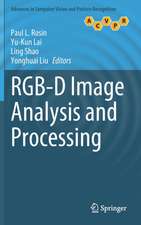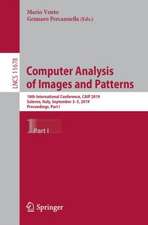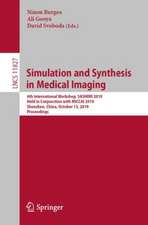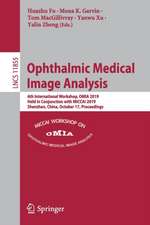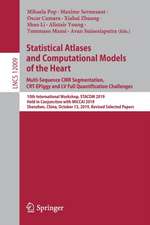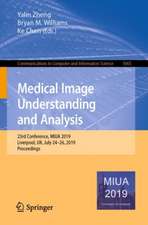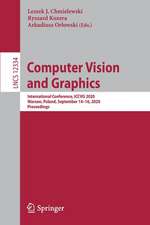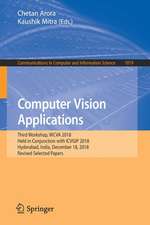Human Action Recognition with Depth Cameras: SpringerBriefs in Computer Science
Autor Jiang Wang, Zicheng Liu, Ying Wuen Limba Engleză Paperback – 4 feb 2014
Din seria SpringerBriefs in Computer Science
-
 Preț: 475.83 lei
Preț: 475.83 lei - 20%
 Preț: 296.17 lei
Preț: 296.17 lei -
 Preț: 446.47 lei
Preț: 446.47 lei -
 Preț: 381.81 lei
Preț: 381.81 lei - 20%
 Preț: 166.97 lei
Preț: 166.97 lei - 20%
 Preț: 325.63 lei
Preț: 325.63 lei - 20%
 Preț: 302.48 lei
Preț: 302.48 lei - 20%
 Preț: 335.65 lei
Preț: 335.65 lei - 20%
 Preț: 406.90 lei
Preț: 406.90 lei - 20%
 Preț: 323.00 lei
Preț: 323.00 lei - 20%
 Preț: 323.00 lei
Preț: 323.00 lei - 20%
 Preț: 322.81 lei
Preț: 322.81 lei - 20%
 Preț: 322.35 lei
Preț: 322.35 lei - 20%
 Preț: 321.85 lei
Preț: 321.85 lei -
 Preț: 375.45 lei
Preț: 375.45 lei - 20%
 Preț: 232.68 lei
Preț: 232.68 lei - 20%
 Preț: 324.17 lei
Preț: 324.17 lei - 20%
 Preț: 323.00 lei
Preț: 323.00 lei - 20%
 Preț: 322.17 lei
Preț: 322.17 lei - 20%
 Preț: 322.50 lei
Preț: 322.50 lei - 20%
 Preț: 323.34 lei
Preț: 323.34 lei - 20%
 Preț: 324.17 lei
Preț: 324.17 lei - 20%
 Preț: 323.46 lei
Preț: 323.46 lei - 20%
 Preț: 322.17 lei
Preț: 322.17 lei - 20%
 Preț: 322.02 lei
Preț: 322.02 lei - 20%
 Preț: 323.46 lei
Preț: 323.46 lei -
 Preț: 374.08 lei
Preț: 374.08 lei -
 Preț: 341.50 lei
Preț: 341.50 lei - 20%
 Preț: 324.49 lei
Preț: 324.49 lei -
 Preț: 344.47 lei
Preț: 344.47 lei -
 Preț: 376.80 lei
Preț: 376.80 lei -
 Preț: 377.18 lei
Preț: 377.18 lei - 20%
 Preț: 324.17 lei
Preț: 324.17 lei - 20%
 Preț: 352.26 lei
Preț: 352.26 lei - 20%
 Preț: 321.32 lei
Preț: 321.32 lei - 20%
 Preț: 322.17 lei
Preț: 322.17 lei - 20%
 Preț: 324.17 lei
Preț: 324.17 lei - 20%
 Preț: 322.02 lei
Preț: 322.02 lei -
 Preț: 374.46 lei
Preț: 374.46 lei - 20%
 Preț: 320.21 lei
Preț: 320.21 lei - 20%
 Preț: 323.34 lei
Preț: 323.34 lei - 20%
 Preț: 324.17 lei
Preț: 324.17 lei - 20%
 Preț: 231.84 lei
Preț: 231.84 lei - 20%
 Preț: 294.95 lei
Preț: 294.95 lei - 20%
 Preț: 322.50 lei
Preț: 322.50 lei -
 Preț: 408.23 lei
Preț: 408.23 lei - 20%
 Preț: 321.52 lei
Preț: 321.52 lei - 20%
 Preț: 323.34 lei
Preț: 323.34 lei - 20%
 Preț: 323.00 lei
Preț: 323.00 lei - 20%
 Preț: 323.80 lei
Preț: 323.80 lei
Preț: 321.20 lei
Preț vechi: 401.49 lei
-20% Nou
Puncte Express: 482
Preț estimativ în valută:
61.46€ • 63.51$ • 51.13£
61.46€ • 63.51$ • 51.13£
Carte tipărită la comandă
Livrare economică 19 martie-02 aprilie
Preluare comenzi: 021 569.72.76
Specificații
ISBN-13: 9783319045603
ISBN-10: 3319045601
Pagini: 68
Ilustrații: VIII, 59 p. 32 illus., 9 illus. in color.
Dimensiuni: 155 x 235 x 4 mm
Greutate: 0.11 kg
Ediția:2014
Editura: Springer International Publishing
Colecția Springer
Seria SpringerBriefs in Computer Science
Locul publicării:Cham, Switzerland
ISBN-10: 3319045601
Pagini: 68
Ilustrații: VIII, 59 p. 32 illus., 9 illus. in color.
Dimensiuni: 155 x 235 x 4 mm
Greutate: 0.11 kg
Ediția:2014
Editura: Springer International Publishing
Colecția Springer
Seria SpringerBriefs in Computer Science
Locul publicării:Cham, Switzerland
Public țintă
ResearchCuprins
Introduction.- Learning Actionlet Ensemble for 3D Human Action Recognition.- Random Occupancy Patterns.- Conclusion.
Recenzii
“It is a relatively short but self-contained volume that presents recent advances in the popular research area of human action recognition. … I was quite pleased when the student, to whom I passed the book for a through read, told me at the end that he found it very useful and a good start for his research. ... book is a good read for someone with an existing background in depth camera technology and research about human action recognition.” (Nicola Bellotto, IAPR Newsletter, Vol. 37 (2), 2015)
Textul de pe ultima copertă
Action recognition is an enabling technology for many real world applications, such as human-computer interaction, surveillance, video retrieval, retirement home monitoring, and robotics. In the past decade, it has attracted a great amount of interest in the research community. Recently, the commoditization of depth sensors has generated much excitement in action recognition from depth sensors. New depth sensor technology has enabled many applications that were not feasible before. On one hand, action recognition becomes far easier with depth sensors. On the other hand, the drive to recognize more complex actions presents new challenges.
One crucial aspect of action recognition is to extract discriminative features. The depth maps have completely different characteristics from the RGB images. Directly applying features designed for RGB images does not work.
Complex actions usually involve complicated temporal structures, human-object interactions, and person-person contacts. New machine learning algorithms need to be developed to learn these complex structures.
This work enables the reader to quickly familiarize themselves with the latest research in depth-sensor based action recognition, and to gain a deeper understanding of recently developed techniques. It will be of great use for both researchers and practitioners who are interested in human action recognition with depth sensors.
The text focuses on feature representation and machine learning algorithms for action recognition from depth sensors. After presenting a comprehensive overview of the state of the art in action recognition from depth data, the authors then provide in-depth descriptions of their recently developed feature representations and machine learning techniques, including lower-level depth and skeleton features, higher-level representations to model the temporal structure and human-object interactions, and feature selection techniques for occlusion handling.
One crucial aspect of action recognition is to extract discriminative features. The depth maps have completely different characteristics from the RGB images. Directly applying features designed for RGB images does not work.
Complex actions usually involve complicated temporal structures, human-object interactions, and person-person contacts. New machine learning algorithms need to be developed to learn these complex structures.
This work enables the reader to quickly familiarize themselves with the latest research in depth-sensor based action recognition, and to gain a deeper understanding of recently developed techniques. It will be of great use for both researchers and practitioners who are interested in human action recognition with depth sensors.
The text focuses on feature representation and machine learning algorithms for action recognition from depth sensors. After presenting a comprehensive overview of the state of the art in action recognition from depth data, the authors then provide in-depth descriptions of their recently developed feature representations and machine learning techniques, including lower-level depth and skeleton features, higher-level representations to model the temporal structure and human-object interactions, and feature selection techniques for occlusion handling.
Caracteristici
Presents a comprehensive overview of the state of the art in feature representation and machine learning algorithms for action recognition from depth sensors Provides in-depth descriptions of novel feature representations and machine learning techniques Covers lower-level depth and skeleton features, higher-level representations to model temporal structure and human-object interactions, and feature selection techniques for occlusion handling Includes supplementary material: sn.pub/extras






